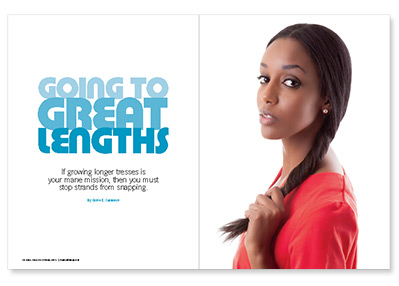
All hair types go through three stages of growth and shedding. The first stage is called the anagen, or active, phase and lasts from two to six years. The longer the hair is in this phase, the faster and longer it grows. The length of this phase varies from person to person and is determined by genetics.
The second stage of hair growth is called the catagen phase, which is a “transitional stage” lasting from two to three weeks. Then the hair enters the final stage, called the telogen, or resting phase, which lasts from one to four months. During this phase the hair shaft doesn’t grow. Instead, hair strands already present are pushed up and out, a process called shedding. This makes way for a new hair shaft to form, and thus—unless a medical issue is present—the hair growth cycle begins again.
Essentially, our hair strands—the part that we see and wash and style—are lifeless (that’s why strands don’t hurt when they’re cut). But this dead hair needs special care. And lacking that, the ends can break off and seemingly grind the growth cycle to a halt.
Specifically, if you use chemical relaxers and permanent hair dyes, and if you subject your hair to heat, styling tools and damaging hair styles such as too-tight extensions, then your beloved—but dead—strands will disappear. (Translation: You’ll be bald!)
To avoid this nightmare and take the first step to hair growth and retention, maintain a healthy, clean scalp, free of infections and product buildup.
The scalp is the birthplace of hair, and if kept in proper condition, it will provide an optimal environment for the follicles to produce quality tresses, writes Audrey Davis-Sivasothy, author of The Science of Hair: A Comprehensive Guide to Textured Hair. The scalp should remain “clean, toned, pliable and positively stimulated,” she stresses.
The key to creating a healthy environment for the scalp is to maintain an overall healthy body. Illness, stress, hormonal changes and vitamin deficiencies can all lead to poor hair health.
When the body is suffering from disease and needs to heal, it takes nutrients from nonessential areas such as the scalp and sends them to vital organs. Also, some prescription drugs can be harmful to hair.
A healthful diet with foods that have a good balance of vitamins and minerals encourages the hair to grow strong and healthy. Fad diets that restrict certain food groups can lead to hair problems, as does avoiding healthy unsaturated fats that, along with omega 3 fatty acids, help the body absorb vitamins.
Another key to optimal health, and hair lengthening growth, is getting plenty of rest, drinking an adequate amount of water and exercising to cut down on stress and to keep the body functioning properly.
In general, moisture is essential to hair growth. But this is especially key for African-American hair. Because of black hair’s curly nature, it’s difficult for the natural oils produced by the scalp to move down the hair shaft. This is why it’s crucial to keep African-American hair moisturized.
To support the growth of long, luscious locks, moisturize hair several times a week or when it feels dry. Use water-based moisturizers that are free of mineral oil and petrolatum. Davis- Sivasothy suggests that if you can’t find products without these substances, at least make sure they are low on the ingredients list.
The best times to moisturize the hair are prior to combing or styling, before going outdoors and after you’ve rinsed out the conditioner. In addition, be sure to focus on the ends. What’s more, moisturize and tie up your tresses at night—with a silk or satin scarf—to reduce friction.
Finally, always remember that black hair requires tender loving care, so avoid anything that further weakens and damages your locks. This means limit heat styling, always apply thermal protectants on tresses and set your appliance’s controls on the lowest setting. And don’t go crazy with chemical processes, such as perms, relaxers and permanent hair color.
Take these measures every day, and you’ll find that you’ve unlocked the secret to growing black hair that’s strong—and long.







4 Comments
4 Comments